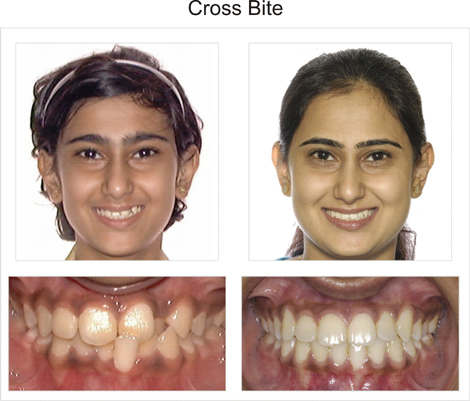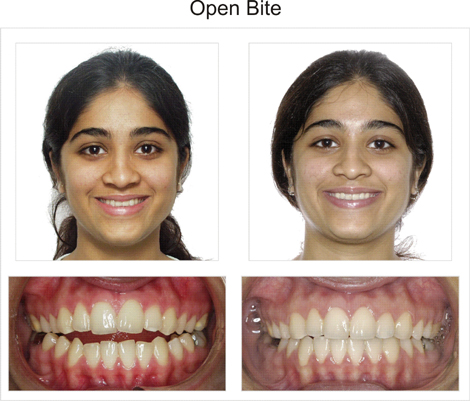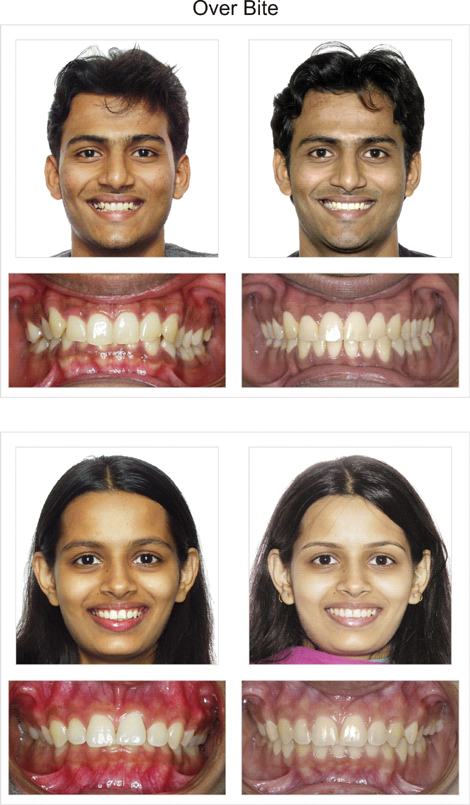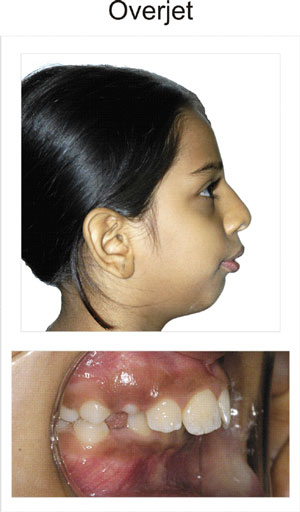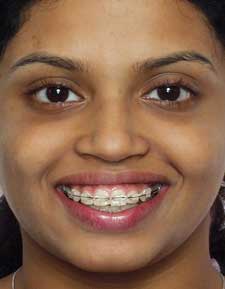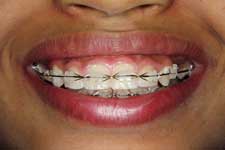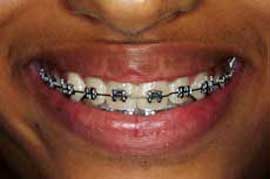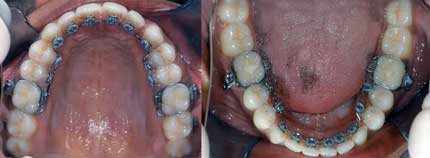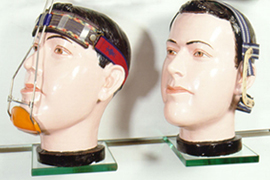Orthodontic Appliances
At Stoma Advanced Dental Care, we take pride in working with the latest techniques so that you receive
the most up-to-date treatments to create your perfect smile. We are experts in straightening
teeth of children, youth and adult. From braces to retainers, we strive to ensure
the highest standards of patient care and treatment to give you a smile that is
both functional and aesthetically pleasing.We also believe in early treatment for
young children to intercept and prevent complicated dental problems.
We have a team headed by Dr Ashok Dhoble -- a highly professional orthodontist,
with extensive training. He has experience with complex orthodontic problems and
dedication to training. You can expect high quality orthodontic treatment at Stoma Advanced Dental Care
with customized treatment plan and programme which will deliver straight teeth and
a beautiful smile.
An attractive smile is a vital asset to personal self-confidence. The effects of
straightening of crooked teeth on an individual's psychosocial well-being can be
tremendous and orthodontics in childhood can make significant changes in increasing
one's later quality of life. Having an attractive smile with well aligned teeth
promotes positive impressions with regards to one's intelligence, social and career
success. Visit Stoma Advanced Dental Care for a range of orthodontic appliances to straighten your smile.
Orthodontic treatment at Stoma Advanced Dental Care
In technical terms orthodontics is the dental science that deals with diagnosing,
correcting, and preventing irregularities of the teeth (malocclusion) or poor occlusion,
disproportionate jaw relationships. Orthodontics includes dento-facial orthopaedics,
which is used to correct problems involving the growth of the jaw. It is a science
that enhances your face value by adding to the beauty of your smile.
Orthodontic treatment today is the best solution for most people before any cosmetic
treatment like veneers, laminates etc. Since the treatment usually takes six months
to two years to complete, we recommend that the mal-positioned teeth be aligned
first. It does not ruin natural teeth but instead, leaves it intact and is almost
a permanent solution
Most people are under the impression that braces are meant only for children. Today
about 40% of our patients are adults who seek our help to straighten teeth, close
gaps or enhance their smile. With technology advancement orthodontics offers tooth
coloured barely visible braces, or even those that fit on the back of your teeth
that are not visible at all. Treatment typically lasts from 6 to 30 months, depending
on age, and the severity of the orthodontic problem. Outstanding results are also
dependent on maximizing the coordination of care between you and our practice. We
are committed to delivering the best possible service in order for you to achieve
your orthodontic objectives. Orthodontists generally use braces and retainers to
set your teeth. Additional components — including removable appliances ("plates"),
headgear, expansion appliances, and many other devices—may also be used to move
teeth and jaw bones. After a course of active orthodontic treatment, patients have
to wear retainers, which maintain the teeth in their improved positions while surrounding
bone reforms around them. The retainers are generally worn full-time for a short
period, perhaps six months to a year, then part-time (typically, nightly during
sleep) for as long as the orthodontist recommends.
Treatment Plan
Your dentist may recommend orthodontic treatment for your teeth and proper jaw alignment.
Crooked and crowded teeth are hard to clean and maintain. This can result in tooth
decay, worsen gum disease and lead to tooth loss. Other orthodontic problems can
contribute to abnormal wear of tooth surfaces, inefficient chewing function, excessive
stress on gum tissue and the bone that supports the teeth, or misalignment of the
jaw joints. These can lead to chronic headaches and face or neck pain.
Orthodontic treatment can be successful at any age, and adults especially appreciate
the benefits of a beautiful smile. More and more adult patients are taking up orthodontic
treatment in this day and age and there are many options to enable braces to be
much more discreet than before.
Stoma’s Technological Edge
Digi-graph is used to produce high-resolution images of facial and tooth structures
at various steps of treatment. We can diagnose the anomalies and pathologies associated
with teeth and jaws. Our three- dimensional sonic digitizing helps design and simulate
the ideal smile in advance for you. We incorporate your preferences considering
your overall looks, thus an attractive smile which suits your face structure.
Our orthodontic diagnostic and treatment computer program allows patient to visualize
facial changes likely to occur with growth, orthodontic treatment or jaw surgery.
Our patients find this to be an extremely helpful tool to visualize "before" and
"after" affects.
Stoma’s Recommendations
Stoma Advanced Dental Care recommends orthodontic treatment in the early teens. This is the time when
children have lost their deciduous teeth and their permanent teeth are erupting.
It is during this time that over-crowding or incorrect tooth positions are seen.
This is known as the occlusion. Where teeth do not ‘fitting together’is known as
a malocclusion.
Orthodontic treatment aims to correct malocclusions by moving the natural teeth
into the correct or ideal positions. The treatment can be carried out in different
ways. There are removable appliances which can be used for a few hours per day in
case of mild malocclusion. These appliances apply mild forces to natural teeth.
Fixed appliance are recommended if malocclusion is severe. Fixed orthodontic brackets
are fixed to natural teeth. These small brackets can be made of stainless steel,
titanium, gold or ceramic. Once the brackets are fixed to the natural teeth they
are joined or connected with an arch- wire. The arch wire with the small slot inside
the bracket will provide the force to straighten the teeth. For this reason it is
very important that the brackets are correctly positioned on the teeth.
Orthodontic treatment is unique and requires a specific and custom treatment plan.
Some patients require minor changes to their occlusion and treatment may only take
a few months to complete. Others require greater teeth movements and longer treatment
times.
As mentioned above if orthodontic problems are not corrected early in life this
leads to the following:-
-
Teeth which are over-crowded, crooked are difficult to clean and maintain free from
plaque resulting in cavities, gum diseases and eventual loss of teeth.
-
Digestive disturbances resulting from the inability to chew food properly.
-
Protruding teeth are more prone to accidents and injuries.
-
A poor bite can cause extra stress on the chewing muscles and may cause pains in
the jaw joints, headaches, neck or facial pains, hearing difficulties, rigging in
the ears, dizziness and muscle twitching.
-
Speech and pronunciation become better after the orthodontic treatment. (Singers,
Dramatists, Executives, Voice actors and professors rejoice)
-
Bad bites also can result in abnormal or excessive wear of the tooth surfaces.
Your Initial Visit
At your first visit to Stoma Advanced Dental Care, we will conduct a thorough oral examination of your
skeletal, extra-oral and intra-oral structures. The treatment is planned out on
the basis of the examination results, the radiographs and primary casts made during
the first appointment.
Plaster models of your mouth are made so that your dentist can measure your tooth
size, how your teeth fit together, and determine how much space is going to be needed
in the future. These models enable the dentist to work out the details of your treatment.
X-rays are also taken of your head and teeth. These reveal your bone structure and
how your teeth fit together. Your x-rays are sent by your dentist to a Growth Centre,
where highly trained technicians make tracings which show key anatomical points.
This information is then fed into a computer. The results of this computer analysis
give your dentist a Treatment Design and a Growth Forecast.
We will discuss the diagnosis, treatment plan and expected results. We will endeavor
to answer all of your questions. If there are individual problems of some other
nature that might influence the acceptance of treatment, this is the opportune time
for discussing them
Next, orthodontic appliances are placed in the mouth, the patient is given thorough,
illustrated and interesting explanations and instructions as to the proper way to
take care of the newly acquired appliances. Tooth brushing technique is gone over
in detail. The reasons for brushing in a specific way are explained. Questions are
invited and answered to the best of our ability. Here again, understanding means
respect for and appreciation of the appliances, or braces, and their care.
Children's Orthodontics
Stoma Advanced Dental Care recommends that a child's first visit to see the orthodontist is around age
7 - 9, for a screening assessment to advise if orthodontic treatment is required
and the best time for treatment. The first permanent molars and incisors have usually
come in by that time and cross bites, crowding and other problems can be evaluated.
When treatment is initiated at an early age, the orthodontist can guide the growth
of the jaw and guide incoming permanent teeth. Early treatment can also regulate
the width of the upper and lower dental arches, gain space for permanent teeth,
avoid the need for permanent tooth extractions, reduce likelihood of impacted permanent
teeth, correct thumb-sucking, and eliminate abnormal swallowing or speech problems.
In many cases, early treatment as an interceptive measure will simplify treatment
in later years
Orthodontic treatment at Stoma Advanced Dental Care corrects
Orthodontics is the specialty of dentistry focused on the diagnosis and treatment
of dental and associated facial irregularities. Orthodontic problems, which can
result from genetic and environmental factors, must be diagnosed before treatment
begins. Proper diagnosis involves taking photographs, x- rays, and dental impressions,
which enable our practice to make informative decisions about the form of treatment
necessary.
On the average, about 45-50% of orthodontic patients require the removal of four
bicuspid teeth to achieve optimal results and satisfactory treatment, but if the
patient visits at early age around at the age of ten year the possibility of removal
of teeth for braces treatment is less. There are consequences of not removing teeth
when indicated, just as there are consequences of removing them too often.
Treatment typically lasts from 6 to 30 months, depending on age, and the severity
of the orthodontic problem. Outstanding results are also dependent on maximizing
the coordination of care between you and our practice. We are committed to delivering
the best possible service in order for you to achieve your orthodontic objectives.
Children and adults need Orthodontics to correct the following: -
Crossbite can occur in the front and/or the sides of the mouth: One or more upper
teeth bite on the inside of the lower teeth. This can occur with a single tooth
or multiple teeth. Early correction of crossbite is recommended.
Crossbite should be corrected because it can:
-
cause premature wear of the teeth
-
cause gum disease including bone loss
-
cause asymmetrical development of the jaws
-
cause dysfunctional chewing patterns
-
make your smile less attractive
If there is a single tooth crossbite, the tooth can be moved with braces into the
correct position. In some cases, a retainer can be utilized. With multiple teeth
in crossbite, the arch needs to be expanded with braces or other intra-oral appliances
Open-bite
Openbite is an insufficient vertical overlap of the teeth. It is caused by oral
habits such as tongue thrust, digit sucking or when the jaws don’t grow evenly.
Timing of treatment is critical to the overall success of the therapy.
Openbite can be corrected through growth modification of the jaws using braces,
extrusion of the anterior teeth and in some cases surgical correction of the jaws.
Also breaking oral habits, such as digit sucking, will facilitate the correction
of an openbite.
Class II Overbite Correction
Overbite occurs when the upper front teeth protrude over the lower front teeth.
Generally there is no contact between the upper and lower front teeth. Often you
cannot see the lower incisors. Overbite is due to a disproportionate amount of eruption
of front teeth or over development of the bone that supports the teeth and a front
to back discrepancy in the growth of the upper or lower jaw (Class II Relationship).
Overbite is also known as a deep bite.
Overbite should be corrected because it can:
-
cause improper functioning of your front teeth
-
result in the lower front teeth biting into the gum tissue of the upper palate leading
to tissue problems
-
unusual wear of the lower front teeth
-
cause jaw or joint problems
-
make your smile less attractive
Overbite can be corrected through moving the front teeth up and/or bringing the
back teeth together, which will “open” the bite so the teeth are properly aligned
and the deep bite is eliminated.
Class II Overjet Correction
Overjet is also known as protrusion. In this case, the lower teeth are too far behind
the upper front teeth. This can be caused by an improper alignment of the molars
(Class II Relationship), a skeletal imbalance of the upper and lower jaw; flared
upper incisors, missing lower teeth or a combination of all the above. In addition,
oral habits such as thumb sucking, finger sucking or tongue thrusting can exacerbate
the condition.
Overjet should be corrected because it can:
-
prevent proper functioning of the front teeth
-
lead to premature wear
-
make your smile less attractive
Overjet can be corrected through growth modification using a functional appliance
and/or elastics to reduce the skeletal imbalance or extraction of teeth.
Class III Underbite Correction
The lower teeth protrude past the front teeth. An underbite is usually caused by
undergrowth of the upper jaw, overgrowth of the lower jaw, or a combination of the
two (Class III Relationship). Underbite can also be caused by flared upper incisors,
missing lower teeth or a combination of all the above. Early correction of underbite
is recommended.
Underbite should be corrected because it can:
-
prevent proper functioning of the front teeth or molars which can lead to premature
wear of the teeth
-
cause chewing or eating problems
-
cause jaw or joint problems
-
make your smile less attractive
Underbite can be corrected through growth modification of the jaws, extraction of
teeth and in some cases, surgical correction of the jaws.
TMD or Temporo-Mandibular Joint Dysfunction
TMD is associated with neck and back spasms, arthritis, cranial neuralgias, even
fibromyalgia; but more often than not, it's the direct result of a bad bite with
a heavy habit of tooth clenching and grinding.
Typical symptoms include joint and/or face pain, clicking or crackling joints, ringing
in the ear, headaches, limited opening of the mouth, and soreness after chewing
certain foods or after long dental procedures. While 20% of the population are aware
of one or more TMD symptoms, only about 5% think it's serious enough to seek treatment
for it.
Needless to say, the TMD should be treated and resolved before any definitive dental
treatment is considered whether it be reconstruction or orthodontic treatment.
Treatment Duration
Treatment time typically ranges from one to three years, depending on the growth
of the patient's mouth and face and the severity of the problem. Patients grow at
different rates and will respond variously to orthodontic treatment, so the time
to case completion may differ from the original estimate. Timings may also vary
depending on the patient's compliance with treatment, particularly with wearing
prescribed rubber bands, removable appliances or maintaining a sensible diet that
does not cause numerous breakages to the brace.
Braces - Orthodontics
Braces
Braces use constant, gentle pressure, which over time, move teeth into their proper
positions. Your braces are at work every moment of your orthodontic treatment. The
two main components of your braces are:- the brackets that are placed on your teeth
and the main archwire that connects them. The bracket is a piece of shaped metal
or ceramic that we affix to each tooth. The archwire is bent to reflect your "ideal"
bite. In other words, it reflects the way we want you to look after treatment.
The wire threads through the brackets and, as the wire tries to return to its original
shape, it applies pressure to move your teeth. Attached to your braces, elastics
(rubber bands) exert the proper force that creates the right amount of pressure
to move teeth. In order for this force to remain constant, elastics must be worn
all the time and changed every day.
Ceramic Braces
That resembles your tooth colour so closely that discriminating it from your teeth
becomes a visual challenge. Tooth coloured braces are made of tooth-coloured porcelain
and are an excellent choice for those who need to wear fixed braces but don’t want
to advertise it. They are fast acting and detail the position of the teeth very
accurately, achieving your beautiful smile faster.
Metal Braces
Metal braces are the most popular with kids and teenagers. They love using different
colors of ligature ties. These braces are much smaller than ever before.
Gold braces are the newest addition to our line of brackets. They are stainless
steel braces coated with 24 karat gold. They have the strength of metal, but blend
in with the color of the teeth much better. That is because most teeth have a natural
yellow tint.
Lingual Braces
Lingual orthodontics is the correction of misaligned teeth, using a fixed brace,
bonded on the inner surface of the teeth. A lingual brace works in the same way
as a conventional fixed brace, with full control and movement of the teeth, but
is nearly invisible, the only person who knows you have a brace is you.
Lingual braces can be for everyone, if you have healthy gums and bones. With Lingual
braces, if you are an adult or adolescent, there are individual solutions to individual
problems. This is the ultimate in invisible brace options.
Functional Braces
These are used specifically on growing children to correct prominent or “sticking
out” front teeth. In our clinic we use upper and lower plastic removable braces
worn together to hold the lower jaw in a forward posture. This stretches the jaw
muscles so that the lips function normally in front of the upper teeth creating
an orthodontic force to push the upper front teeth back and the lower front teeth
forward. It sounds complicated but it works if it is worn all the time (other than
for eating and contact sports).
Invisalign
Invisalign is the clinically accepted, nearly invisible way to straighten your teeth
and improve your smile-without braces. When you begin treatment, you’ll wear each
custom-made aligner for 22 hours a day and change them every 2 weeks. The aligners
gently move your teeth by 0.25mm incrementally into a new position. After 2 weeks,
you “graduate” to the next one in the series. You only remove them for eating, drinking
& cleaning or for special occasions. As you progress through the series of aligners,
your teeth will begin moving, little by little. And you’re on your way to the smile
you’ve always dreamed of! For most adults, treatment time is just about one year.
Removable Appliances
Removable appliances, unlike conventional braces, are used to retain teeth in their
corrected positions and in some cases, to influence growth of the jaws in order
to effect changes in facial structure. In addition, they are often used before and
in conjunction with fixed appliances.
Although removable appliances can easily be taken out by the patient, there may
be a tendency not to wear them as we have prescribed. This means your teeth, jaws
and muscles may move back toward their original positions.
Headgear
Orthodontic headgear creates forces that guide the growth of the face and jaws.
It is also used to move teeth into better positions or to prevent teeth from moving.
Maintaining constant use of your headgear will achieve the best results. If instructions
on usage are not followed, treatment will take longer and our treatment plan may
have to change.
Always be careful when removing your headgear. If the headgear is removed carelessly,
the part that fits in your mouth and attaches to your teeth could injure your lips,
cheeks, face and possibly your eyes.
Splint therapy
Splint therapy has three aims: (1) eliminate the TMJ complaints, (2) identify the
correct jaw-joint relationship, and (3) determine whether or not the complaints
can be resolved. Splint therapy consists of biweekly or so visits of relining and/or
adjusting the splint for 3-6 months or until the TMJ complaints are resolved. The
splint construction incorporates an ideal functional occlusion and with adjustments
and relines over time. It just might provide the most comfortable bite. It must
be worn full time, especially while eating.
Orthodontics and Surgery
Growth abnormalities of the jaw are corrected by an oral surgeon. These can be heredity,
trauma or other developmental problems like protruding or retruding chin; an unsightly
display of gum tissue above the upper front teeth; an inability to achieve lip contact
when the lips are relaxed; over all elongation of the face, or asymmetry. Teeth
are aligned on the upper and lower jaws, when the jaws are too short or long, too
wide or narrow, the proper bite often cannot be achieved with braces alone.
In these cases, orthodontic treatment and surgery are combined to straighten the
teeth and oral surgery to correct severe cases of bad bites and jawbone abnormalities.
The orthodontist, in conjunction with the oral surgeon, formulates a combined treatment
plan that may include surgery performed by the oral surgeon. Orthodontics and Surgery
may be the only treatment option in some severe cases.
Orthodontic appliances are used to align teeth before surgery are left in place
during the surgical procedure to help stabilize the teeth and jaws. After surgery
there is a period of orthodontic treatment to achieve final alignment of the teeth,
thus complementing the new facial symmetry.
Surgery can be avoided for children as young as age 7. One or several orthodontic
appliances guide bone growth, thus eliminating the need for surgery in some patients.
However, in non- growing patients, the improper tooth/bone relationship frequently
is corrected with surgery.
Call Stoma Advanced Dental Care to fix an appointment for an orthodontic treatment and walk away with
beautiful, healthy and happy you.
Recall
We recommend regular check-up. This will take care of cavities and a thorough cleaning.
Recall appointments are integral part of the orthodontic treatment. The success
of the treatment is assessed during the recall appointments. It is essential to
schedule timely recall appointments to check for relapse and evaluate the progress.
